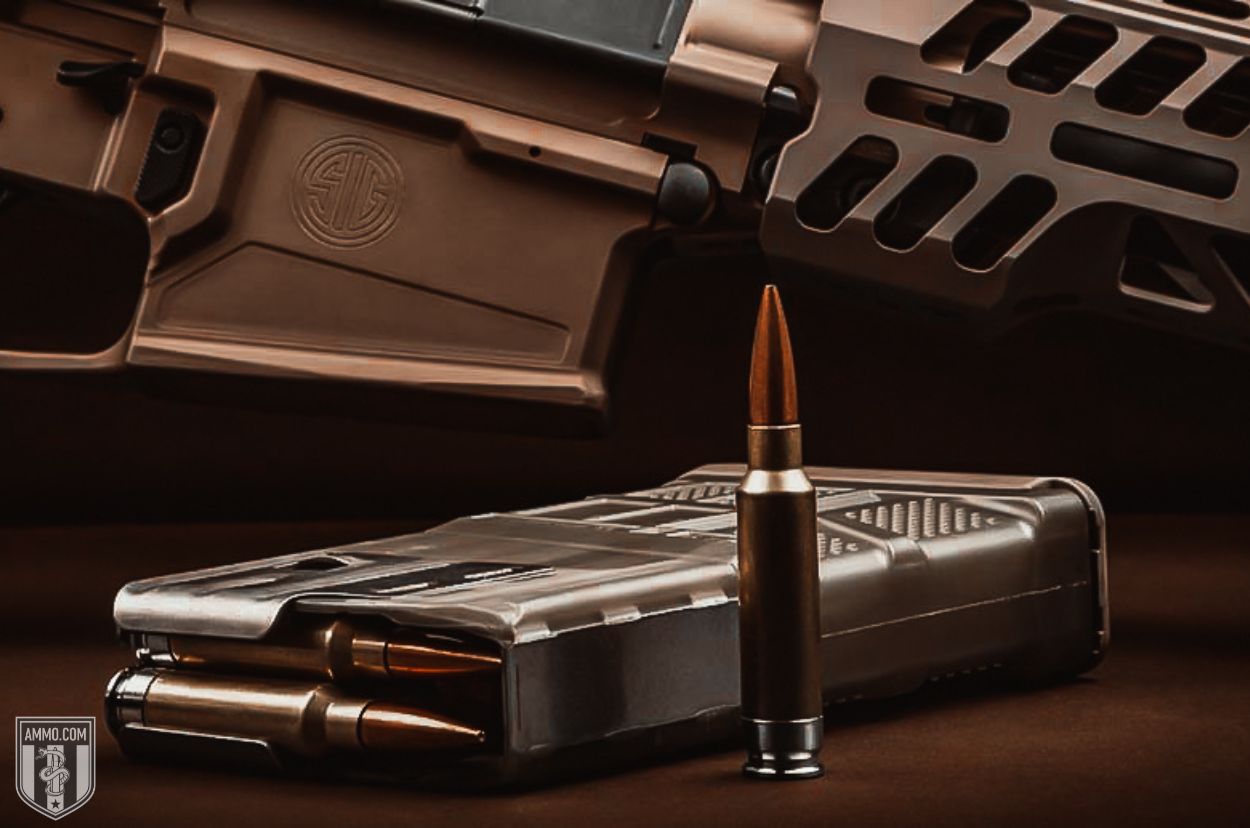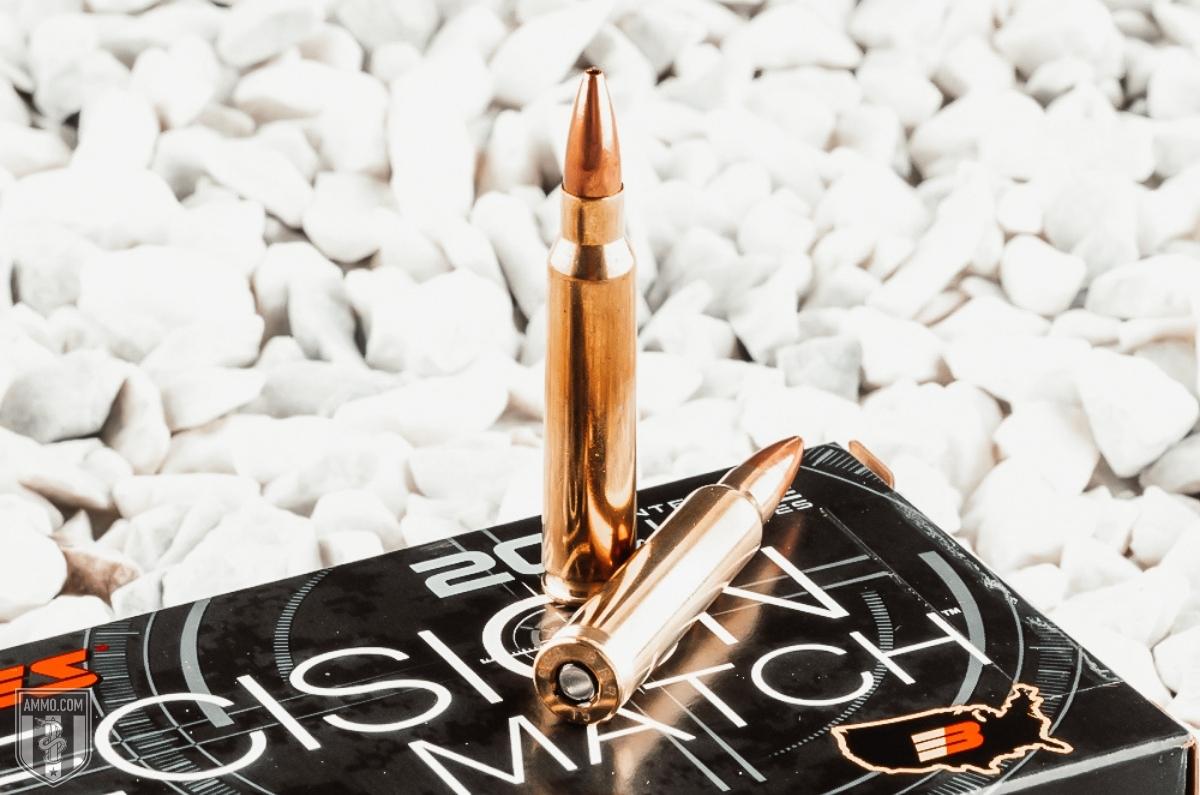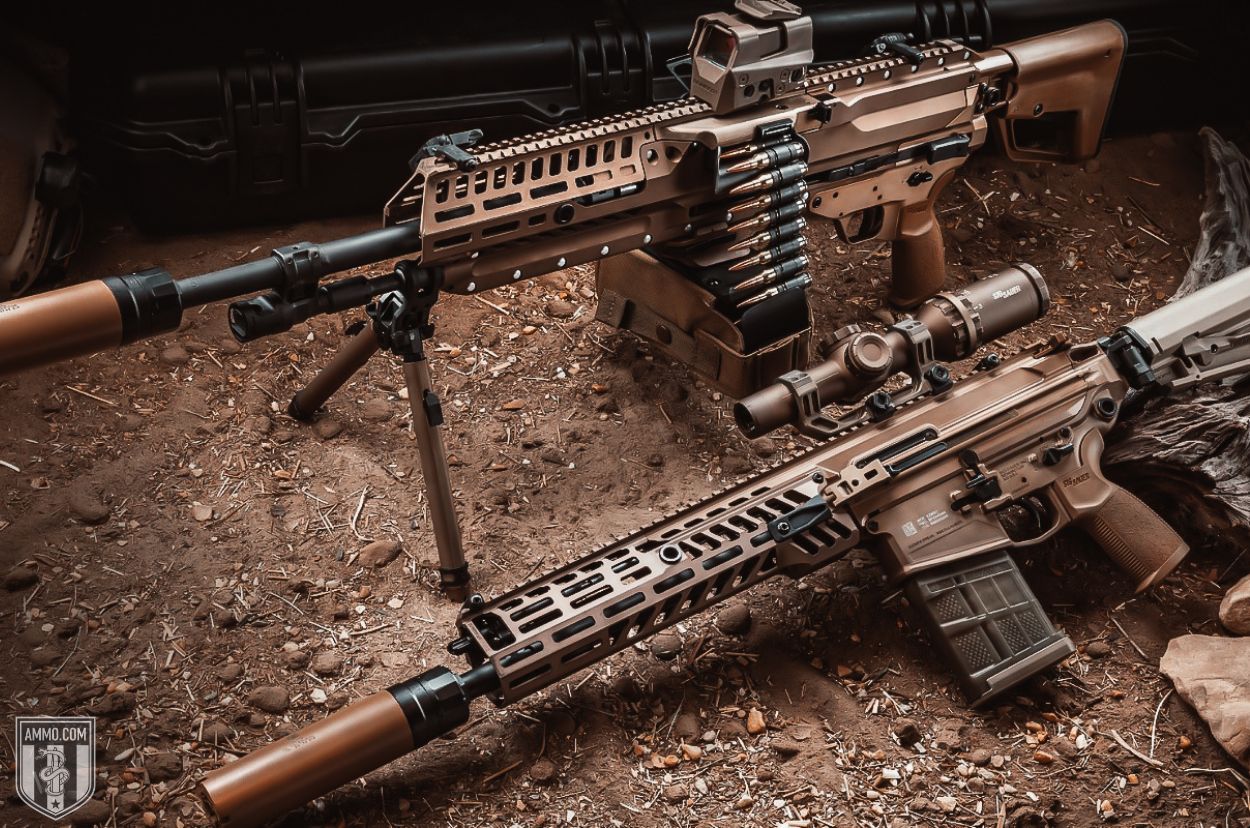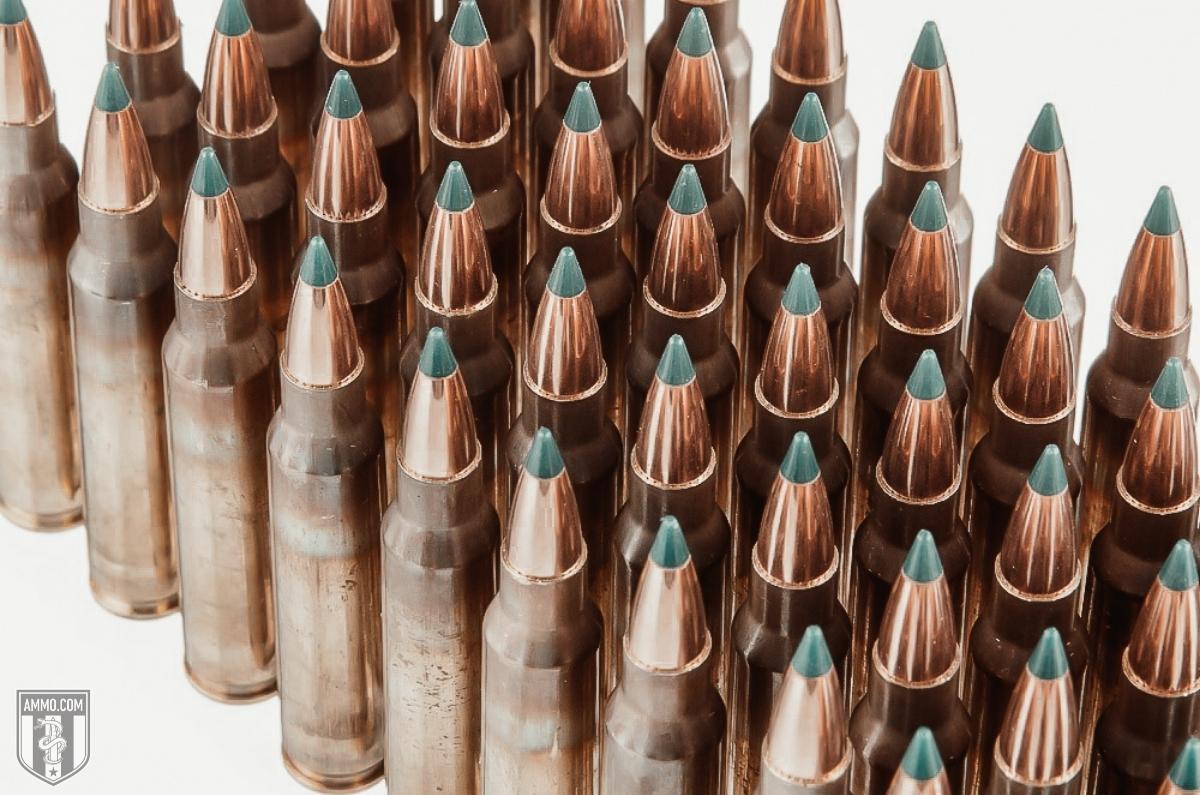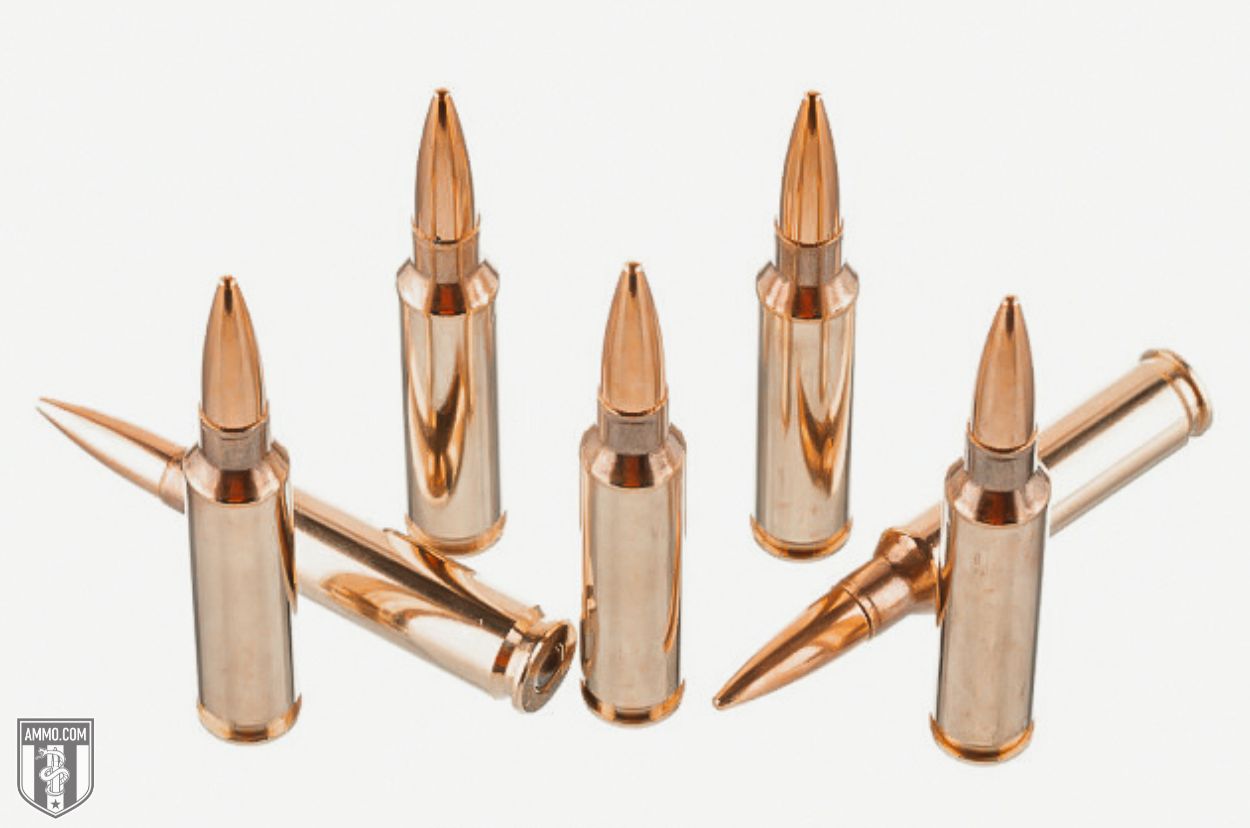277 Fury Vs 5.56 NATO: Is It Worth the Switch?

When the US Army announced that the 277 Sig Fury was the new rifle cartridge for the Next Generation Squad Weapon Program (NGSW Program), rumors instantly began circulating that it was the end of the 5.56 NATO round. After all, the 277 Fury was designed to replace the 5.56 NATO on the battlefield.
Should we all sell our 5.56 rifles and ammo and start stockpiling the new cartridge, the 277 Fury?
Let’s find out!
Below, we've compared the 277 Fury vs 5.56 in several common scenarios so you can determine which round is best for you.
.277 Fury vs 5.56 Caliber Comparison
Ideally, we could perform a head-to-head comparison of these small arms rounds, but it's never an apples-to-apples comparison. Each cartridge outshines the other in certain instances.
We will rank each caliber in various categories and tally the wins at the article's end to decide which is best for each shooter.
But first, let's begin with the cartridge specifications for each round.
Cartridge Specs
The 277 Sig Fury launches a 0.278” projectile, typically ranging from 130 gr to 150 gr, while the 5.56 shoots a 0.224” bullet, typically weighing 55 gr to 85 gr.
The base diameter of the 5.56 is 0.377”, whereas the 277 Fury has a base diameter of 0.470”. The 277 Fury case is also significantly longer than the 5.56 NATO case, at 2.015” and 1.760”, respectively. The larger bullets and longer cartridge case contribute to the 277 Sig Fury being over half an inch longer than the 5.56.
It's apparent the new round, the 277 Fury, is larger than the 5.56.

Sig Sauer claims it doesn’t have a parent case because the case is a unique design, but its dimensions are eerily similar to a .308 Winchester cartridge. The 277 Fury has the same case length and base diameter as the beloved .308 Win, though they shoot projectiles with different diameters.
Many battle-hardened veterans believe the large size of the rounds could be the most significant drawback for soldiers on the battlefield because it reduces the number of rounds a magazine can hold and, therefore, a soldier can carry.
The maximum pressure difference of these two calibers stands out the most. As of this writing, the new 277 Fury has the highest chamber pressure of any round approved by SAAMI. At 80,000 psi, the 277 Fury has a much higher pressure than the 55,114 psi of the 5.56.
This significant pressure increase is thanks partly to the 54-grain case capacity and the three-piece hybrid case that is 20% lighter than a traditional solid brass case, which the 5.56 uses most of the time. The 277 Fury cartridge utilizes a brass body with an aluminum lock washer that connects to a stainless steel base (the case head).
The 5.56 NATO utilizes the traditional solid brass case with a 28.5-grain case capacity and is not capable of withstanding such high pressures without damaging the firearm or injuring the shooter.
It would be tough to confuse these two rounds at the range due to the drastic size difference. While these rounds appear to be developed for different purposes, the US Military planned for the 277 Fury to replace the 5.56 NATO in many of its M4 carbines with the XM5 (Sig’s MCX Spear rifle) and XM250 (Sig’s MG-338).
The Sig Cross Rifle is the civilian bolt-action hunting and long-range shooting platform chambered in several calibers, including 277 Fury.
The President and CEO of Sig Sauer, Ron Cohen, bragged about the 277 Fury in an introductory statement about the round-
“The revolutionary SIG FURY ammunition is the most technically advanced leap in small arms ammunition in over 150 years; this turns your intermediate rifle platform into magnum performance without the added weight or length…"
Now, let's move on to how each round performs for shooters in the real world.
Recoil
Recoil is a major concern for new and experienced shooters; one of the first questions I always ask is, “How’s the recoil?” It’s not that I’m scared of the kick; I just want to know what to expect.
When I introduced my wife and mother-in-law to my new 5.56 rifle, they were not blown away by the recoil (pun intended). As a matter of fact, they were both shocked at how little recoil my AR-15 had.
That’s because the 5.56 NATO has about 4 lbs of felt recoil.
On the other hand, the 277 Fury feels like a 308 Win with about 20 lbs of felt recoil.
Yes, having less recoil is easier on the shoulder; it also aids in being more accurate because you’re less likely to flinch or anticipate the shot. Less recoil also helps in quicker follow-up shots, which are critical for the military, law enforcement, and home defense situations.
With 5X less recoil, the 5.56 NATO easily wins this category.
Trajectory
The trajectory is the bullet's flight path measured by bullet drop in inches. In other words, how flat does the projectile fly? Does it look like half of the McDonald’s sign, or is it a straight line?

The 277 Fury was designed to pierce body armor at long range, so it should have a reasonably flat trajectory, especially with this cartridge's high pressure.
When the 277 Sig Fury is zeroed in at 100 yards through a 16-inch barrel length with a Nosler polymer tipped 150-grain bullet, it drops 3.1" at 200 yards, 24.6" at 400 yards, and 43.7" at 500 yards. That’s a flatter trajectory than the 6.5 Creedmoor, a long-distance shooting legend!
The 5.56 drops 3” at 200 yards, 27.4” at 400 yards, and 54” at 500 yards when shooting a 55gr M193. While these trajectories are similar when we step past 500 yards, the 5.56 takes a nose dive, and the 277 Sig Fury continues its direct line to the target.
The 5.56 NATO can’t match the flat trajectory of the 277 Fury; therefore, the 277 Fury wins this section.
Accuracy
The accuracy of a round is tricky to determine because it depends on many factors, such as the shooter, rifle, optics, bullet, and several other things.
For simplicity’s sake, we will assume all things are as equal as possible, which means the major contributing factors will be recoil and trajectory.
However, since recoil was won by the 5.56 and trajectory was won by the 277 Fury, we must add some qualifiers.
When shooting within 500 yards, the 5.56 NATO will be the caliber of choice for most shooters because it has minimal recoil and a reasonably flat trajectory out to this distance.
When we are shooting further than 500 yards, the 277 Fury is more accurate, thanks to its flatter trajectory.
Since the 277 Fury is more accurate at greater distances, it wins this section. But don’t think for a second that the 5.56 isn’t deadly accurate within 500 yards.
Ballistic Coefficient
The ballistic coefficient (BC) is how mathematically aerodynamic a bullet is and how much the projectile resists wind drift.
Heavier bullets generally have a higher BC. A higher BC means the bullet is more aerodynamic (streamlined) or better resists crosswinds, so it is less susceptible to wind drift than lower BC projectiles.
Considering this, the 277 Fury should have the higher BC bullet, and it does by nearly double.
A 5.56 55gr FMJ generally has a BC of around 0.259.
The 150gr polymer tipped 277 Fury has a BC of .500; that's basically double. In other words, it will drift about half as much in the wind because it’s twice as aerodynamic as the average 5.56 bullet.
This is another significant reason why the 277 Fury is better for long-distance shooting.
The 277 Fury uses much more aerodynamic bullets and has a much higher ballistic coefficient; therefore, the 277 Sig Fury wins this category.
Stopping Power
The stopping power and effective range of rounds are always argued in gun forums. Luckily, there’s not much argument to be had amongst these rounds.
The 277 Fury shoots a nearly three times larger projectile at a slightly slower muzzle velocity (300 fps less) than the 5.56, which means the 277 Fury will have much more stopping power.
The sectional density (SD) is a way we determine the ability of a bullet to penetrate (terminal performance) based on its external dimensions, design, and weight.
Since the 277 Fury was designed to penetrate body armor, the rounds intended for the American Military and law enforcement will also have a high SD compared to the 5.56 NATO.
The 277 Fury takes the cake in this category, too.
Hunting
While neither caliber was designed for hunting, the 277 Fury should be the top choice because the 5.56 is the smallest legal hunting caliber in many states and can’t legally bring down big game animals like elk, bear, or hogs.
It’s still unproven, so only time will tell if the 277 Fury will replace the 6.8 SPC for long-range hunting. That’s a tall task, in my opinion.
The 5.56 is primarily limited to close-range deer and varmint hunting in the states that allow it as a legal cartridge.
The 277 Fury has the potential to take the hunting world by storm, or it could be another forgotten round by the American hunter. Whatever happens, the 277 Sig Fury is a better option for hunting than the 5.56 NATO in most instances.
Home Defense
You’re probably thinking that the 277 Fury is about to rattle off another win, but "Hold your horses," as my Pawpa used to tell me as a kid.
The 277 Fury has more stopping power and is better for hunting; we’ve established this.
BUT, no, it's not better for self-defense.
The AR-15 weapon system chambered in 5.56 NATO has proven incredibly effective in home defense situations because most home invaders are not wearing body armor, and the 5.56 bullet is much less likely to over-penetrate into your neighbor's house.
Two other reasons I prefer the 5.56 NATO over the 277 Fury for home defense are the higher magazine capacity and the lower recoil. This means I have more chances of hitting my target and faster follow-up shots when I miss.
While I also prefer a 12 gauge shotgun in home defense scenarios, I'll grab my AR-15 chambered in 5.56 when my shotgun is unavailable.
The 5.56 NATO surprises some and wins this section.
Ammo and Rifle Cost/Availability
Let's be honest: most shooters don’t have an unlimited budget, so the budget is a significant concern for the average shooter, myself included.
I wish I had a giant stack of cash to carelessly spend on guns and ammo, but I don't, so I must make the dollars stretch where I can so my wife doesn’t start asking where all our money went!
The 5.56 NATO has been around for decades; after all, it was used in Vietnam. So it's easy to come by and reasonably priced (most of the time).
You can find 5.56 ammo for $0.50-$0.70 per round, especially when you buy 5.56 NATO rounds in bulk. For more options, check out our Wolf ammo 5.56x45 page.
Rifles chambered in 5.56 are also reasonably priced and easy to find. You can get a short-action hunting rifle chambered in 5.56 NATO/223 Remington for just over $500. At the same time, 5.56 NATO AR-15s cost $600-$1,200.
The 277 Fury is an entirely different story. The rifles and ammo are not readily available because it's still a newly developed round.
While available, 277 Fury ammo is extremely limited because it’s only produced at the Lake City Ammunition Plant, and most is earmarked for the US Military.
277 Fury rifles are also incredibly expensive compared to 5.56 NATO rifles. A Sig Cross Rifle, one of the only firearms chambered in 277 Fury available to civilians, is very difficult to find, and when you do, it will cost you $2,000 or more.
Unless you have wads of cash burning a hole in your wallet and you don’t mind scouring the planet for a rifle, the 5.56 NATO wins this section.
As more shooters become aware of the 277 Fury, and big ammo companies like Federal, Hornady, Remington, and Winchester begin producing rifles and ammo for this caliber, I see the prices dropping in a similar price range as the 308 Win or 6.5 Grendel.
Reloading
You can save a little money by handloading and reloading ammo. This also gives you complete control of the ammo-making process to craft the perfect round for your firearm.
However, it’s also time-consuming, so there are trade-offs.
The information and reloading equipment is readily available for 5.56 NATO rounds, whereas since the 277 Fury is still new, the information and equipment are limited.
I also don’t know how the three-piece hybrid casing of the 277 Fury will hold up to reloading.
For now, the 5.56 NATO is a much friendlier round to reload than the 277 Fury, but I suspect that will change as the 277 Fury becomes more established in the coming years.
.277 Fury vs 5.56 Ballistics
Below, the team at Ammo.com has taken the liberty of creating a couple of ballistics tables for the 277 Fury and the 5.56 NATO.
These ballistics tables include the muzzle velocity (FPS), muzzle energy (ft-lbs), and trajectory of the bullets.
.277 Fury Ballistics Table

Note: This information comes from the manufacturer and is only informational. The actual ballistics obtained with your firearm can vary considerably from the advertised ballistics. Also, ballistics can vary from lot to lot with the same brand and type load.
5.56 Ballistics Table
| 5.56x45mm Bullet WEIGHT | Muzzle VELOCITY (fps) | Muzzle ENERGY (ft. lbs.) | TRAJECTORY (in.) | |||||||||||
|---|---|---|---|---|---|---|---|---|---|---|---|---|---|---|
| Muzzle | 100 yds. | 200 yds. | 300 yds. | 400 yds. | Muzzle | 100 yds. | 200 yds. | 300 yds. | 400 yds. | 100 yds. | 200 yds. | 300 yds. | 400 yds. | |
| 55 Grain NATO | 3130 | 2740 | 2382 | 2051 | 1750 | 1196 | 917 | 693 | 514 | 372 | 1.1 | 0 | -7.3 | -23 |
| 75 Grain NATO | 2910 | 2676 | 2543 | 2242 | 2041 | 1410 | 1192 | 1002 | 837 | 693 | 1.2 | 0 | -7 | -21 |
Note: This information comes from the manufacturer and is only informational. The actual ballistics obtained with your firearm can vary considerably from the advertised ballistics. Also, ballistics can vary from lot to lot with the same brand and type load.
5.56 Development
In 1957, the United States Continental Army Command (CONARC) asked for a lightweight rifle that shot a variation of .22 caliber ammunition.
By early 1962, the specifications of the 223 Rem were turned into the Sporting Arms and Ammunition Manufacturers’ Institute (SAAMI). In July, SAAMI recommended proceeding with the .223 Remington.
However, it wasn’t until 1964 that the U.S. Army officially adopted the .223 Remington as the 5.56mm ball cartridge M193, which eventually became the 5.56x45mm NATO.
This ammunition was first used in the Army’s M-16 rifles during the Vietnam War, where it proved deadly and effective. Today, 5.56 NATO is one of America's most popular, if not the most popular, calibers for target shooting and some hunting scenarios.
.277 Fury Development
The 277 Sig Fury is a relatively new cartridge created by Sig Sauer for the Next Generation Squad Weapons military procurement solicitations. The exact details of the development of the 277 Fury are still classified. Still, we know the US Army wanted it to pierce current and future body armor at 500 yards, something the 5.56 NATO cannot do.
At the end of 2019, the creation of the 277 Fury was first announced. However, the SAAMI committee members couldn't meet to approve the new cartridge until 2021 due to COVID-19 travel restrictions. Eventually, it was approved, and ammo is currently produced at Lake City Arsenal.
Sig Sauer is the primary manufacturer of 277 Fury rifles. Still, I wouldn’t be surprised to see many other rifle makers chambering their rifles in 277 Sig Fury as the cartridge gains popularity.
As civilians, we're waiting for more companies to add the 277 Fury to their ammo and rifle lineups.
Parting Shots
Now that you’ve finished reading our 277 Fury vs 5.56 NATO comparison, you might wonder why the government would spend so much money and time developing a round similar to the 308 Win… All I can say is that it’s the government. Does anyone know why they do what they do?
If you kept track of the category wins, you know that the 277 Fury won 5/9 categories, which means the 5.56 NATO won 4/9.
Both rounds have pros and cons, and it’s ultimately up to you as to which is best for your situation.
Don’t forget to check out what ammo we have in stock at Ammo.com!
Ammo Comparisons
- .308 vs 5.56
- 6.5 Creedmoor vs .308
- .300 Blackout vs .308
- .300 Win Mag vs .308
- .243 vs .308
- .308 vs .30-06
- 7mm-08 vs .308
- .270 vs .308
- 7.62x39 vs .308
- .223 vs .308
- .338 Lapua vs .308
- .380 ACP vs 9mm
- .223 vs 5.56
- .300 Blackout vs 5.56
- 9mm vs 45 ACP
- 9mm vs 40 S&W
- .357 SIG vs 9mm
- 10mm vs 9mm
- 9mm vs 9mm Luger
- .243 vs .270
- .300 Win Mag vs .30-06
- .270 vs .30-06
- .40 vs .45
- 38 Special vs 357
- 9mm vs 40 vs 45
- 5.56 vs 7.62x39
- 338 Lapua vs .30-06
- .30-30 vs .30-06
- 300 PRC vs 338 Lapua
- .30-06 vs 7mm
- 300 Win Mag vs 338 Lapua
- 300 PRC vs 300 Win Mag
- 300 WSM vs 300 Win Mag
- 338 Win Mag vs 338 Lapua
- 12 Gauge vs 20 Gauge
- 10mm vs 357 Mag
- .30-30 vs 7.62x39
- 224 Valkyrie vs 22-250
- 17 HMR vs 22 Mag
- 7.62x39 vs .300 Blackout
- 45 ACP vs 45 Auto
- 45-70 vs 30-30
- 300 Blackout vs 223
- 357 Magnum vs 9mm
- 350 Legend vs 300 Blackout
- 224 Valkyrie vs 223
- 45 ACP vs 38 Super
- 6.5 Grendel vs .308
- 17 HMR vs 22 LR
- 10 Gauge vs 12 Gauge
- 22-250 vs 223
- 45 Colt vs 45 ACP
- 350 Legend vs 30-30
- 5.7x28 vs 223
- 5.7 vs 9mm
- 5.56 vs 5.7
- 22 vs 9mm
- Buckshot vs Birdshot
- 450 Bushmaster vs 308
- 450 Bushmaster vs 223
- Buckshot vs Slug
- 6.5 Grendel vs 5.56 vs 223
- 6mm ARC vs 6.5 Grendel
- 44 vs 45
- 458 SOCOM vs 5.56
- 357 vs 44
- 32 ACP vs 380
- 300 Win Mag vs 338 Win Mag vs 338 Lapua Mag
- 450 Bushmaster vs 458 SOCOM vs 50 Beowulf
- 6mm Creedmoor vs 6.5 Creedmoor
- TMJ vs FMJ
- 44 Special Vs 44 Magnum
- 45 90 vs 45 70
- 6.8 Western vs 6.8 SPC
- 50 Beowulf vs 50 BMG
- 26 Nosler vs 6.5 PRC
- 28 Gauge vs 410
- 6.8 SPC vs 5.56
- 6.8 SPC vs 6.5 Grendel
- 6.8 Western vs 7mm Rem Mag vs .28 Nosler
- 6.8 Western vs 6.5 Creedmoor
- 22 Hornet vs 223
- 6.8 Western vs 6.5 PRC
- .410 vs 12 Gauge
- .410 vs 20 Gauge
- 22 LR vs 22 Mag
- 6mm ARC vs 243
- 7mm-08 vs 270
- 243 vs 6.5 Creedmoor
- Nickel vs Brass Casing
- 204 Ruger vs 223
- 50 Beowulf vs 5.56
- 260 Remington vs 6.5 Creedmoor
- 6mm Remington vs 243
- 28 Nosler vs 300 PRC
- 50 Beowulf vs 50 AE
- 22 Nosler vs 22-250
- 450 Marlin vs 45-70
- 300 Win Mag vs 300 Norma
- 458 SOCOM vs 300 Blackout
- 38-55 vs 45-70
- 22 Hornet vs 22 LR
- 300 Norma vs 338 Lapua
- 338 Lapua vs 50 BMG
- 28 Nosler vs 300 Win Mag
- 28 Nosler vs 6.5 Creedmoor
- 204 vs 22-250
- 458 SOCOM vs 45 70
- 44 40 vs 45 70
- 6.8 SPC vs 6.5 Creedmoor
- 450 Bushmaster vs 30-06
- 7mm Rem Mag vs 300 Win Mag
- 30 Carbine vs 223
- 25-06 vs 30-06
- 26 Nosler vs 28 Nosler
- 16ga vs 12ga
- 30 06 vs 7.62 x54R
- 9mm Makarov vs 9mm Luger
- 350 Legend vs 223
- 30 Carbine vs 5.56
- 6.5x55 vs 6.5 Creedmoor
- 6.5 Creedmoor vs 270 vs 25-06
- M193 vs M855
- 450 Bushmaster vs 458 SOCOM
- 6.5 Grendel vs 6.5 Creedmoor
- 350 Legend vs 5.56
- .277 Fury vs 6.8 SPC
- 277 Fury vs 300 Win Mag
- 10mm vs .45 ACP
- 277 Fury vs 223
- 6.8 SPC vs 300 Blackout
- 6.5 PRC vs 6.5 Creedmoor
- 277 Fury vs 308
- 277 Fury vs 6.5 Creedmoor
- 350 Legend vs 450 Bushmaster
- 277 Fury Vs 5.56 NATO
- 10mm vs 40S&W
- 32 ACP vs 9mm
- 32 Special vs 9mm
- 8.6 Blackout vs 300 Blackout
- 30 Super Carry vs. 9mm
- 5.56 vs 9mm
- .50 Action Express vs 9mm
- 7.62x25 vs. 9mm
- 10mm vs 44 Magnum
- 300 Blackout vs 300 Win Mag
- 6.5 Grendel vs 300 Blackout
- 460 Rowland vs 10mm
- 300 RUM vs 300 PRC
- 300 Norma vs 300 PRC
- 45 GAP vs 45 ACP
- 7mm PRC vs 300 Win Mag
- 300 PRC vs 6.5 Creedmoor

